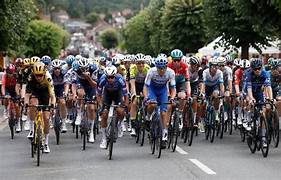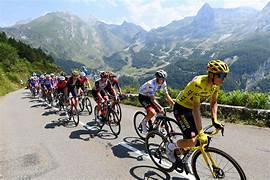Tour de France
The Tour de France is not just a cycling race; it’s a symbol of endurance, strategy, and passion. First held in 1903, it is the most prestigious and well-known cycling event in the world. Organized by Amaury Sport Organisation (ASO), the Tour de France is a multi-stage bicycle race primarily held in France, occasionally passing through neighboring countries. Covering over 3,500 kilometers across 21 stages and lasting three weeks, the race tests the limits of professional cyclists in mountain climbs, time trials, flat sprints, and treacherous descents. The yellow jersey, awarded to the overall leader, is the most iconic symbol in cycling. Millions of spectators line the roads each year, while millions more watch it live on television, making it a global phenomenon.
History and Evolution of the Race
The Tour de France was created by French newspaper L’Auto to boost circulation in 1903. The inaugural edition was won by Maurice Garin, covering 2,428 km in six stages. Over the decades, the race evolved with more stages, stricter rules, and global participation. Interrupted during the two World Wars, the Tour bounced back stronger each time. Legends like Jacques Anquetil, Eddy Merckx, Bernard Hinault, and Miguel Indurain dominated their eras, becoming national heroes. In recent decades, the Tour expanded its start (Grand Départ) to other countries like the UK, Germany, and Denmark, further increasing its international appeal. It’s no longer just a French race—it’s a global sporting event.
Race Format and Jerseys Explained
The Tour is divided into 21 stages, including mountain stages, flat sprints, individual time trials, and team time trials. Riders compete for the overall time, but there are multiple competitions within the Tour:
- Yellow Jersey (Maillot Jaune): Awarded to the overall leader with the lowest cumulative time.
- Green Jersey (Points Classification): Given to the best sprinter.
- Polka Dot Jersey: For the King of the Mountains (best climber).
- White Jersey: Best young rider under the age of 25.
Each jersey has its own strategy, and teams often focus on winning specific ones rather than the overall Tour. There is also a team classification and daily stage wins, making every day a battle in its own right.
The Route and Its Significance
The Tour de France route changes every year but always features a mix of flat stages, mountain climbs in the Alps and Pyrenees, and time trials. The race traditionally ends in Paris on the iconic Champs-Élysées. The mountain stages are the most grueling and decisive parts of the race, often determining the final winner. Climbs like Alpe d’Huez, Mont Ventoux, and Col du Tourmalet are legendary for their steep gradients and history-making moments. Riders must not only be fast but also tactically sharp and mentally resilient to endure these physically punishing terrains.
Famous Tour de France Champions
Some cyclists have achieved legendary status thanks to their performance in the Tour de France:
- Eddy Merckx (Belgium) – 5-time winner, known as “The Cannibal” for his dominance.
- Bernard Hinault (France) – The last French winner (1985), also a five-time champion.
- Miguel Indurain (Spain) – Known for his time-trial power, won five consecutive Tours (1991–1995).
- Chris Froome (UK) – Dominated the 2010s with four victories and strong team support.
- Tadej Pogačar (Slovenia) – Youngest winner in recent history, winning in 2020 and 2021.
These athletes didn’t just win—they left an indelible mark on the sport with their unique styles, rivalries, and incredible endurance.
Teamwork and Strategy in the Tour
The Tour de France is not an individual sport—it’s deeply rooted in team strategy. Each team typically consists of 8 riders with designated roles:
- Team Leader: Main contender for overall victory.
- Domestiques: Support riders who fetch water, block wind, or sacrifice their position to protect the leader.
- Sprinters: Riders specializing in high-speed finishes.
- Climbers: Experts in mountain stages.
Teams use radios, analytics, and pre-stage planning to implement tactics. Whether it’s setting a fast pace to drop rivals, forming breakaways, or launching attacks at the right moment, the team element is crucial to success.
Controversies and Challenges
The Tour de France has seen its share of scandals and controversies, especially regarding doping. The most infamous case was Lance Armstrong, who won seven consecutive Tours (1999–2005) but was later stripped of all titles for using performance-enhancing drugs. The incident led to stricter testing and a major credibility crisis. Despite this, the Tour survived, with new champions emerging from a cleaner era. Another challenge has been crashes and injuries, sometimes caused by unpredictable fans or dangerous descents. In recent years, climate change and road protests have also posed challenges for race organizers.
Modern Era and Technological Advances
Today’s Tour is a high-tech affair. Riders use power meters, aerodynamic gear, and scientific nutrition to gain even the smallest edge. Teams use data analytics to monitor heart rate, cadence, and power output in real-time. The bikes themselves are engineering marvels—lightweight, aerodynamic, and custom-built for each rider. Social media and live streaming have made the Tour more accessible than ever, with fans able to follow their favorite riders through GPS tracking and live telemetry. This modern evolution keeps the Tour relevant for new generations.
Cultural and Economic Impact
The Tour de France is more than a sporting event—it’s a cultural celebration. Towns across France bid to host stages, gaining huge boosts in tourism and media attention. The caravan (a parade of sponsor vehicles before each stage) adds a festive atmosphere, especially for children. Globally, the Tour reaches over 190 countries, with viewership in the hundreds of millions. Economically, it generates massive revenue through sponsorships, tourism, and broadcasting rights. It also promotes cycling as a sport and a healthy lifestyle, inspiring many to take up bikes.
Conclusion: A Legacy That Rides On
The Tour de France is an unrivaled spectacle of human strength, courage, and resilience. It combines tradition with innovation, local charm with international reach, and individual glory with team effort. As it moves into the future, the Tour continues to inspire not just cyclists but anyone who admires determination, discipline, and the pursuit of greatness. With each edition, new heroes emerge, new stories are written, and the legacy of the yellow jersey grows brighter. Whether you’re a hardcore fan or a casual viewer, the Tour de France is a journey worth following.
The Role of Fans and Atmosphere
One of the most unique aspects of the Tour de France is its electrifying atmosphere, created by millions of fans who line the route each year. From the snow-capped mountain passes to the sunflower fields of southern France, spectators cheer passionately for their favorite riders, often camping for days to secure a good viewing spot. The presence of fans, with flags, horns, and homemade signs, adds emotional energy to the race. The Tour caravan, a pre-race procession of sponsor vehicles throwing goodies to the crowd, has become a beloved tradition. For rural French towns, hosting a Tour stage is a matter of pride and celebration, bringing a festive vibe that highlights French culture and local identity.
Training and Physical Demands
Preparing for the Tour de France requires a level of physical and mental discipline that few can imagine. Riders train for months, even years, to peak at the right time. Their training involves high-altitude camps, simulation rides of mountain stages, strict dietary regimes, and strategic rest periods. The Tour’s demands are intense: riders often burn over 6,000 calories per day, spend 4–6 hours daily on the saddle, and face extreme weather conditions. Recovery is just as crucial—massage therapists, physiotherapists, and sleep specialists travel with each team to help athletes maintain their edge. Only the toughest survive the full three weeks, making even finishing the Tour a monumental achievement.
Iconic Moments in Tour History
The Tour de France has seen countless unforgettable moments. In 1989, Greg LeMond won by just 8 seconds, the closest finish in history. In 2011, Cadel Evans of Australia won after a brilliant time trial in the penultimate stage, becoming the first Australian champion. Who can forget Chris Froome running up Mont Ventoux in 2016 after his bike broke in a crash? Then there’s the youthful brilliance of Tadej Pogačar, who stunned the world in 2020 by taking the yellow jersey on the final time trial. These moments reflect the unpredictability and drama of the Tour—where legends are made and history is written, often in seconds.
Looking to the Future of the Tour
As the world changes, so too does the Tour de France. Organizers are working to make the race more inclusive and sustainable. The growing popularity of Tour de France Femmes, the women’s version of the race, is a major step toward gender equality in the sport. Technological innovations like virtual rides, fan engagement apps, and eco-friendly logistics are shaping the modern Tour. Cycling is also becoming a symbol of sustainable transport, and the Tour plays a role in promoting this shift. With rising global interest and young talent from all continents, the future of the Tour de France looks brighter and more exciting than ever.

